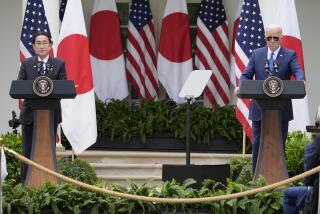One Way Around Rising U.S.-Japan Anger : Troubled relationship needs major injection of new ideas
- Share via
President Clinton is determined to develop a new framework for U.S.-Japan relations. That was apparent from his first meeting with Japanese Prime Minister Kiichi Miyazawa, in Washington last month. The Administration recognizes that the end of the Cold War provides an opportunity for a historic shift in U.S. policy toward Japan. But Clinton fell far short of defining a new paradigm for this important bilateral relationship.
Yes, the President gave firm notice that Washington expects “results” in ratcheting down Japan’s $49-billion trade surplus with the United States. He suggested that Tokyo fatten its $117-billion stimulus program to encourage more American imports. He wants Japan to agree to allocate market shares to U.S. products. His overly glib quip that a stronger yen would help imports catapulted the Japanese currency to record highs against the dollar.
None of these approaches are new. They have been used to varying degrees in various efforts to correct the chronically and grossly uneven exchange of goods and services between the United States and Japan. Yet the trade imbalance and friction continue. Japanese barriers to American goods persist, but market access has not been the sole problem. The U.S. deficit, eroding manufacturing base and declining K-12 education all have reduced American competitiveness. Tokyo, meanwhile, has poured money into new products, technology and markets.
Mutual interests that once converged on security matters now are being pulled apart by competitive economic interests and systems. The challenge is to harness the best of both systems for mutual benefit, and that includes, of course, reducing the trade imbalance. Could Japan help revitalize U.S. manufacturing or could the United States help Japan develop creative basic research?
GROWING TOGETHER: To achieve such synergy requires new ideas. Take Daniel Burstein, who just a few years ago was predicting a possible trade war with Japan in his book “Yen!” Today he is an advocate of a “new post-national economic order on the basis of the combined strengths of the United States and Japan.” In his new book, “Turning the Tables,” Burstein envisions a joint U.S.-Japan endeavor called the “Trans-Pacific Community” that would “be more than a free trade zone and less than a political union.” The goal: long-term economic growth for both nations. The focus would be on cross-border trade, investment, finance, technology sharing and a macroeconomic framework.
He argues that such a de facto U.S.-Japan economic community already is forming through business ventures between Japanese and U.S. companies and the U.S.-Japan dialogue on structural impediments, which has identified problems in both countries. What’s needed, he says, is “the political organization of it.” The Trans-Pacific Community initially would focus on renewing America’s manufacturing, and internationalizing and liberalizing Japanese markets. Eventually it would share institutions and structures to conceive, implement and enforce economic policy.
PANDERING TO FEARS: A political window of opportunity exists now in both the United States and Japan. Fears about a Japan takeover of U.S. industry are cooling. Pandering to such fears in the 1992 New Hampshire presidential primary fizzled when voters did not respond to the Japan-bashing. Thousands of Americans now work in manufacturing jobs at Japanese-owned plants. Finally the realization is growing that Japan has not caused all of the United States’ economic problems.
Japan today looks less like an economic miracle than it did in the 1980s. It is struggling with its own recession after its economic bubble burst. The Tokyo Stock Exchange has stopped walking on water. Property prices are down. Banks are restructuring. Many Japanese companies are now less willing to sacrifice profits to build market share.
The U.S.-Japan partnership is undoubtedly a special relationship that will continue as a defining element in the Asia-Pacific region and the global economy. Together the United States and Japan account for 40% of the world’s gross product, but they need a new shared vision of economic community. Clinton must recognize that rattling the trade sabers alone will not achieve that new cooperation.
More to Read
Sign up for Essential California
The most important California stories and recommendations in your inbox every morning.
You may occasionally receive promotional content from the Los Angeles Times.













